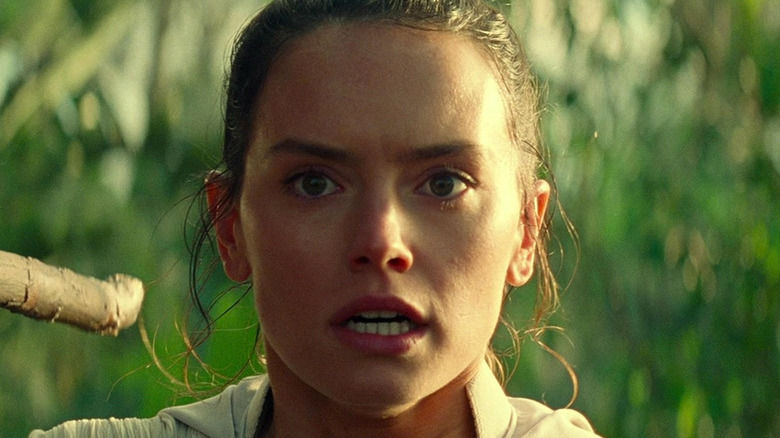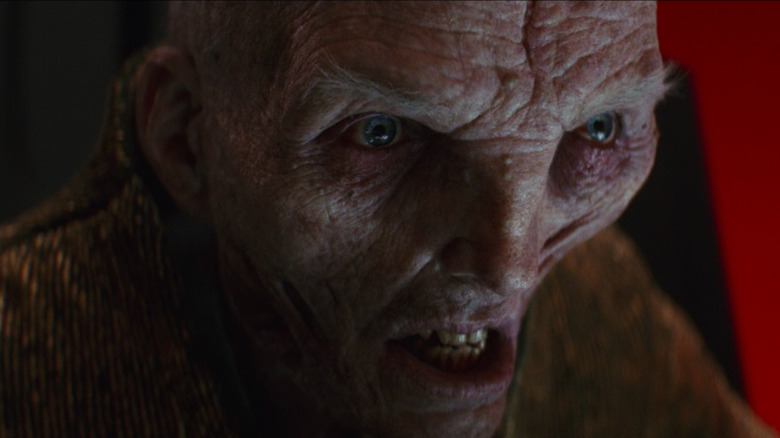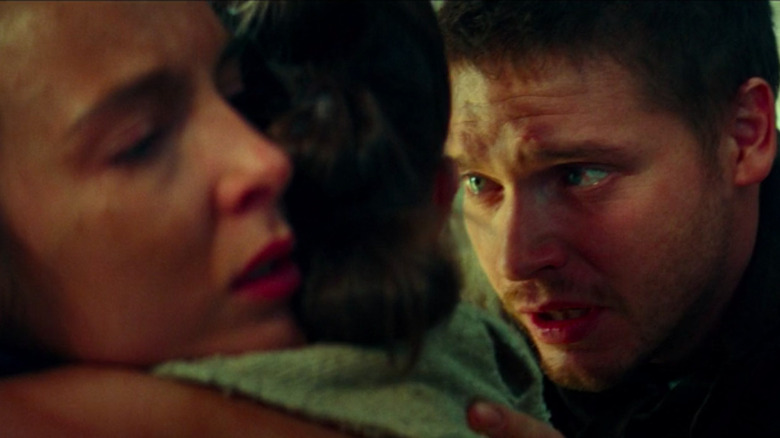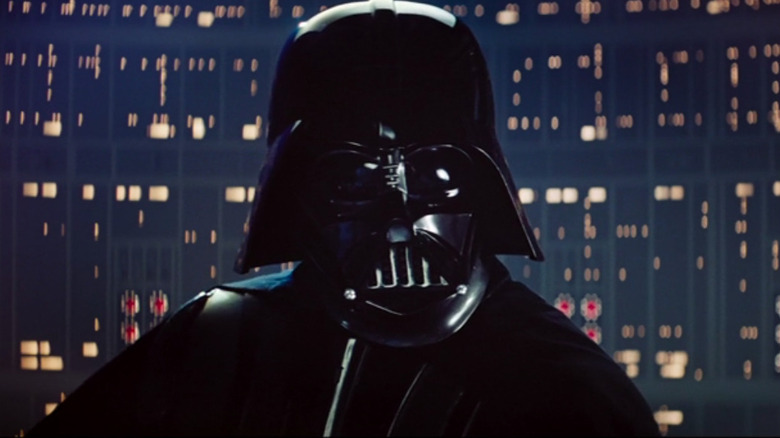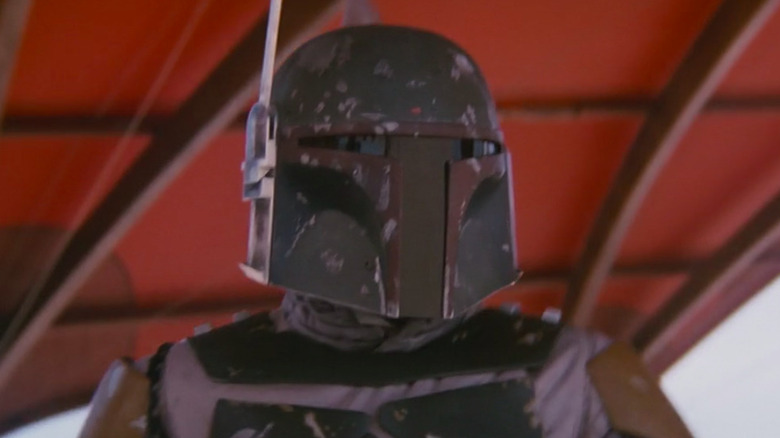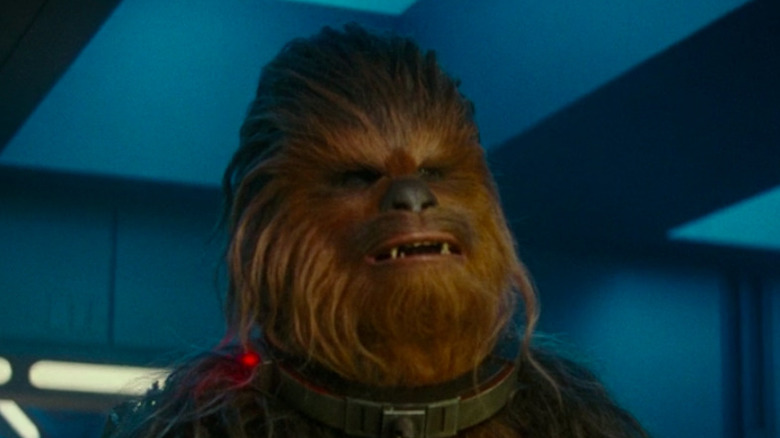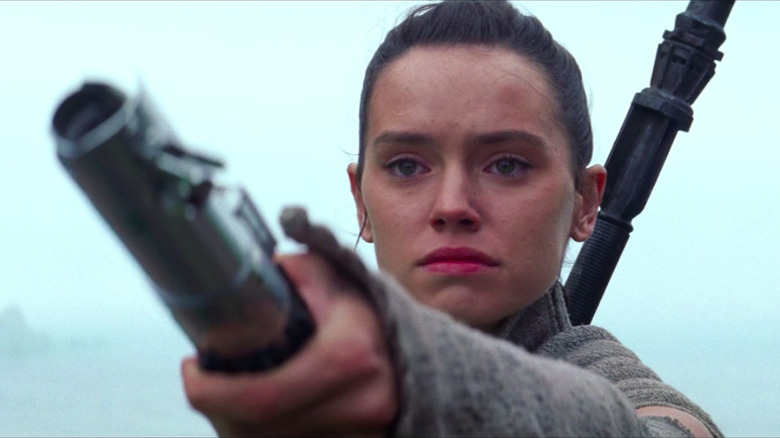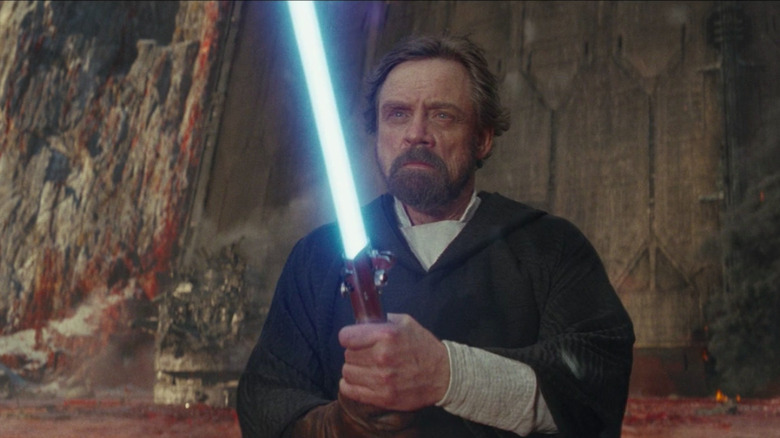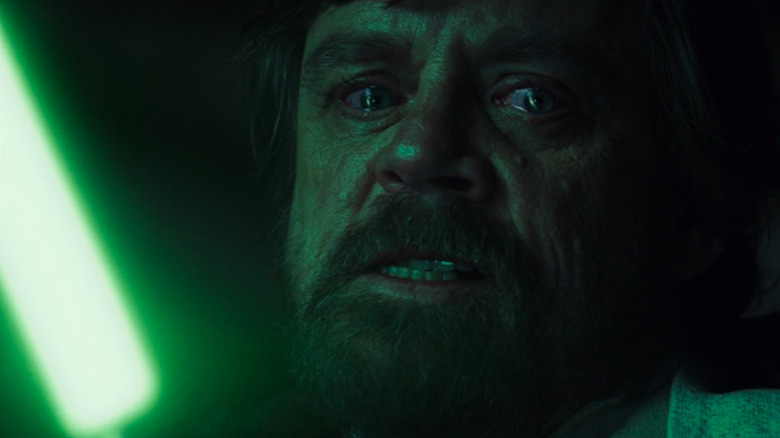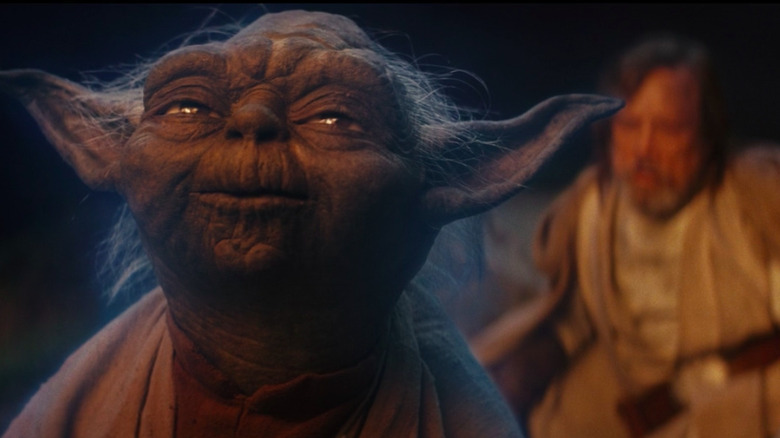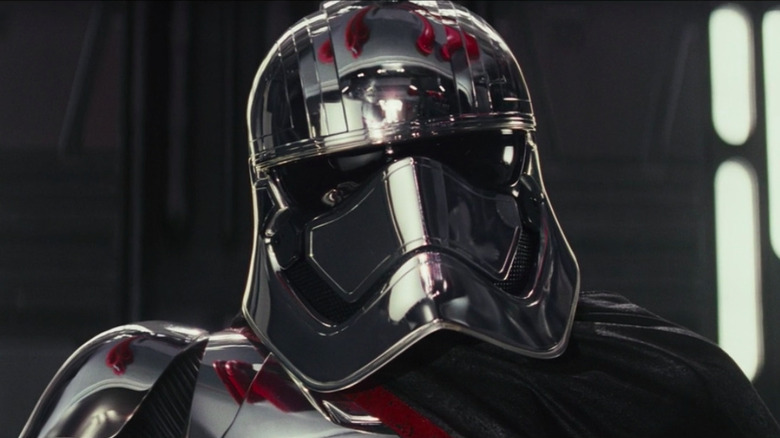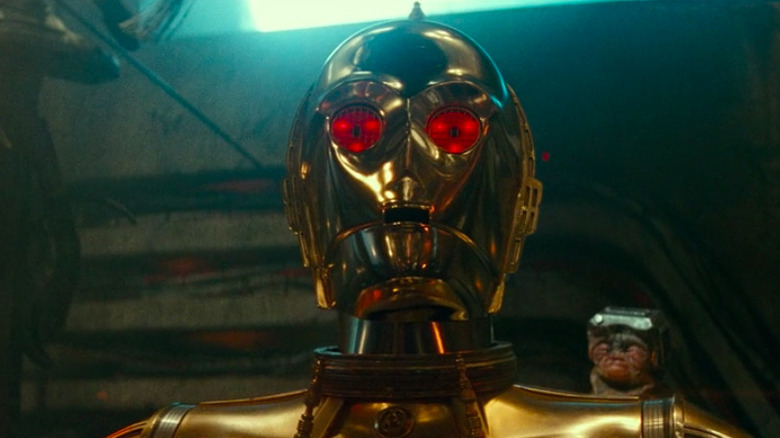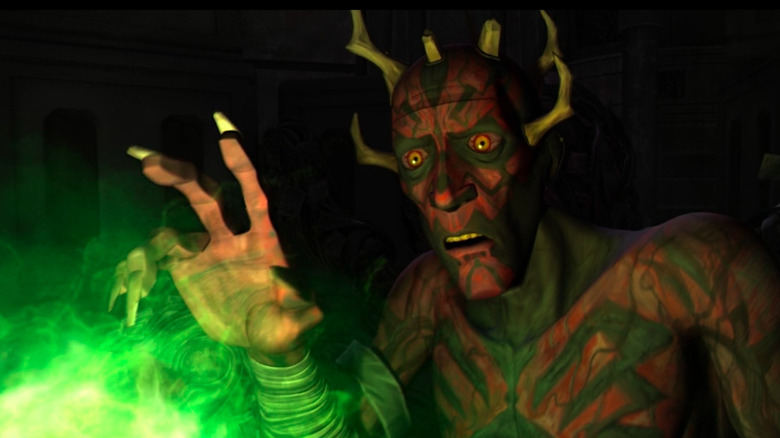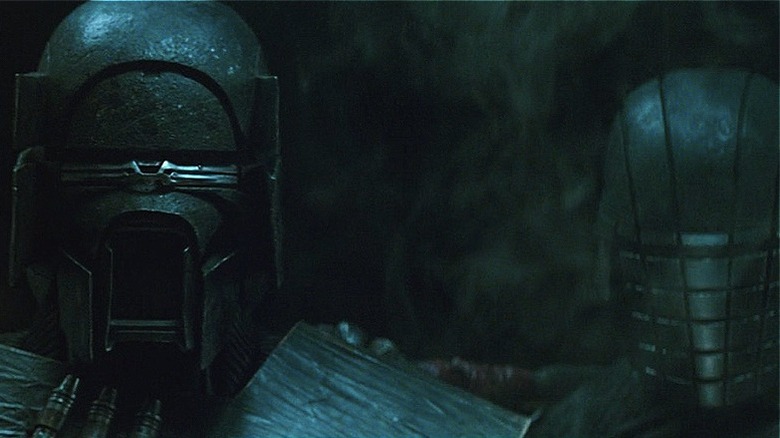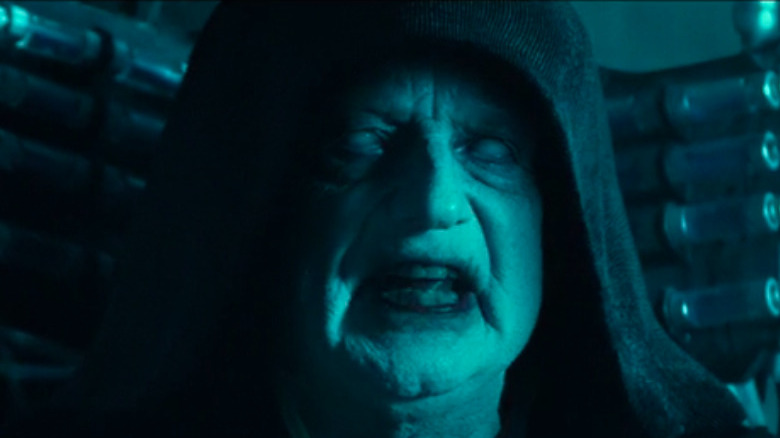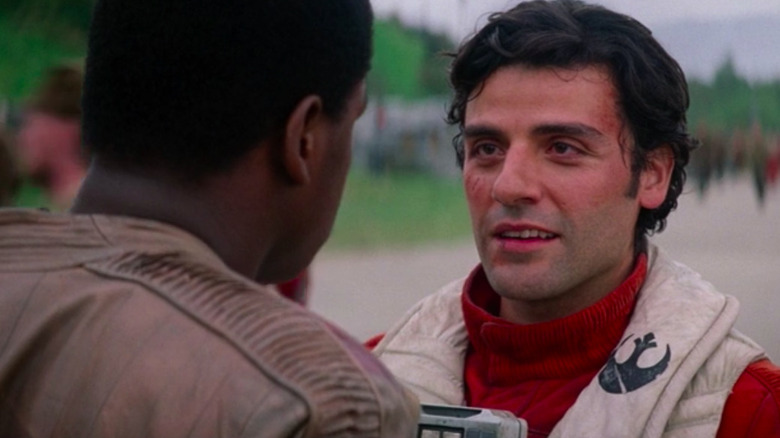The Biggest Red Herrings In The Star Wars Universe
Truth, to paraphrase a certain venerable Jedi Master, can sometimes be a matter of perspective ... unless, of course, it's not remotely true at all. Red herrings have been a staple of the "Star Wars" franchise from the beginning. Major reveals are later proven misleading or outright false, twists turn out to be tricks, and characters initially teased as a big deal are killed off or Force-pushed aside. Not every red herring has been a hit with fans — some have proven to be enormously divisive, in fact, spawning debates that rage for years. Yet others have gone down as some of the most successful red herrings in cinematic history.
An intriguing question emerges from this observation: Which of the "Star Wars" saga's many acts of misdirection are the most memorable? After searching our feelings (and the movies) to better know the truth, we came up with this list. These are the biggest red herrings in the "Star Wars" universe.
Snoke as a main villain
Just as Darth Vader and Grand Moff Tarkin have Emperor Palpatine, so do Kylo Ren and General Hux have their own superior to report to: Supreme Leader Snoke. First appearing in holographic form in "The Force Awakens," Snoke initially seems poised to become the major villain Rey needs to defeat in the "Star Wars" sequel trilogy.
Yet Kylo Ren dashes those expectations by killing Snoke himself in the trilogy's second movie, "The Last Jedi." By slicing him in half with Rey's lightsaber, Kylo pulls off something poetic: The energy sword once belonged to Palpatine's killer, Darth Vader, a man Kylo heavily emulates. Despite these parallels, killing Snoke mid-trilogy is a shocking move, especially since "The Force Awakens" echoes "A New Hope" so closely. This twist sets "The Last Jedi" dramatically apart, and cements Kylo Ren as the sequel films' major villain ... until "The Rise of Skywalker," anyway, when Kylo Ren meets Palpatine, Snoke's actual creator.
Rey's false heritage
The biggest mystery of the sequel trilogy is Rey's heritage. This is also the aspect of the trilogy that throws the most red herrings at viewers. In "The Force Awakens," Rey is assailed by sounds and visions of her past when she touches Anakin Skywalker's original lightsaber, including Obi-Wan Kenobi calling her name. This implies she may have a connection with him, or his fallen apprentice. Yet her adeptness in piloting the Millennium Falcon, as well as her fast camaraderie with Han Solo, suggests a link to the beloved scoundrel.
As Rey's actress Daisy Ridley eventually revealed, tying Rey to Kenobi was indeed the original plan. Yet Kylo Ren upends things in "The Last Jedi" by revealing the "hints" from "The Force Awakens" aren't actually meaningful, and that Rey's parents were deceased junk traders who sold her for drinking money. Moreover, Rey herself even acknowledges she's been aware of their "nobody" status the entire time. Yet in "The Rise of Skywalker," Kylo explains that Rey is descended from Emperor Palpatine. The movie's novelization further states that her father was a flawed Palpatine clone. Fan reaction is deeply divided over this reveal, which stands as one of the sequel trilogy's most dramatic acts of misdirection.
Obi-Wan's claim that Darth Vader killed Anakin Skywalker
This isn't just the most famous red herring in all of "Star Wars" — it might be the most famous in movie history. When Obi-Kan Kenobi tells Luke that Anakin was one of Darth Vader's victims, he sets up the jaw-dropping revelation of Luke's true parentage in "The Empire Strikes Back." "[Obi-Wan] told me enough," Luke hisses, as Vader advances upon him. "He told me you killed him." "No," Vader replies, "I am your father."
This is a twist so big, it was kept secret from nearly every actor in the film, except Mark Hamill and James Earl Jones. Vader being Luke's dad wasn't really part of the original plan (via Yahoo!), which is likely why Obi-Wan's spirit explains that Anakin metaphorically died the day he became Darth Vader. This leads to the classic line, "So what I told you was true ... from a certain point of view." This explanation is echoed in "The Rise of Skywalker" when Kylo Ren tells Rey that what he revealed about her parents in "The Last Jedi" was an incomplete truth, rather than an outright lie.
Boba Fett as a major threat
Even before his incredible fight scenes in "The Mandalorian" were unveiled, Boba Fett was beloved within Star Wars fandom. However, a lot of his fame as the galaxy's most fearsome bounty hunter doesn't actually come from the movies, but from tie-in material like books and comics. In the films, Boba Fett is a pretty small player in the grand scheme of things. Initially, he seems to be meant for more: He is, after all, the bounty hunter who takes Han Solo to Jabba the Hutt, and the camera frequently cuts to him in "Return of the Jedi." Yet Fett is easily defeated when Han Solo accidentally damages his jet pack. The mercenary is slammed against a sail barge before his body rolls into the sarlacc pit.
Perhaps Fett's ample camera time can be explained by the fact that he was originally going to be the main villain in "Return of the Jedi." As Lucasfilm's first fan relations officer Craig Miller explained to Inverse, Fett's role was drastically reduced when George Lucas decided to axe plans for a third trilogy. Thanks to "The Mandalorian," however, Boba Fett has finally managed to shake off his red herring reputation.
Rey seemingly killing Chewbacca
Despite being part of the same story, "The Force Awakens" and "The Last Jedi" are very different movies. The first is deeply reverential to the original trilogy, emulating "A New Hope" beat by beat. Not so with "The Last Jedi." Despite some similarities to "The Empire Strikes Back," it chooses to challenge tradition head-on.
At first, "The Rise of Skywalker" seems like it's following in its immediate predecessor's daring footsteps. When Chewbacca is kidnapped by the First Order, Rey tries rescuing him by using the Force to pull the ship Chewie's supposedly on toward her. Kylo retaliates with his own power. Their Force tug-of-war abruptly ends when Rey unintentionally shoots Force lightning from her fingers, destroying the ship. This is a blow to the gut for longtime Star Wars fans ... until it's proven to be a red herring, when Chewbacca is revealed to have been aboard another craft. The misdirect sets the tone for the rest of the movie: While "The Rise of Skywalker" isn't quite as risk-prone as "The Last Jedi," it's also not afraid to play with expectations.
Rey offering Luke his lightsaber
Most of the trailers and promotional material for "The Force Awakens" have a noticeable lack of Luke Skywalker. This makes sense — he only appears at the very end of the film. After her first major battle with the First Order ends with Han Solo dead and Finn comatose, an emotionally drained Rey uses R2-D2 and BB-8's holographic map to find Luke Skywalker on the planet Ahch-To. In the movie's final moments, Rey offers Luke his first lightsaber, which was originally his father's, as her way of asking for help. The credits roll before Luke makes his response.
While fans might expect Luke to express some reluctance to take his old weapon back, given his failure to restore the Jedi, few predict he'll grouchily toss the weapon away. Yet this is exactly what happens in "The Last Jedi." What's more, Luke has grown so bitter, he feels there shouldn't be any more Jedi period. The final scene of "The Force Awakens" might initially appear to be a message of renewed hope, but Luke's shockingly dismissive reaction in "The Last Jedi" reveals it as a major red herring.
Luke confronting Kylo Ren
Just when it looks like the Resistance has all but lost against the First Order in "The Last Jedi," hope arrives in the form of Luke Skywalker. After subtly showing the Resistance a means of escape and saying his goodbyes to Leia and C-3PO, Luke confronts Kylo Ren directly. He appears to evade a barrage of Imperial Walker fire and Kylo Ren's lightsaber sweeps. When Kylo lands a direct hit on Luke, however, his lightsaber blade goes right through the Jedi Master without actually making physical contact. A shocked Kylo pushes his weapon through Luke's body again, and finds it touches nothing. This "Luke" is a red herring: The real Luke never left Ahch-To, and is instead interacting with Kylo and the Resistance through a Force projection of himself — one that is extremely difficult to maintain from lightyears away.
This red herring is expertly done, though certain clues suggesting things aren't what they seem can be discerned. One is the fact that Luke fights Kylo Ren with Anakin Skywalker's lightsaber, which Ren actually plays a role in destroying in an earlier scene. Leia's expression when Luke kisses her forehead is another hint, as is Luke's knowing wink to C-3PO, who acknowledges Luke's presence but seems somewhat astonished by it. The Resistance leader and protocol droid may very well know the truth before Luke's fight with Kylo even begins.
Luke's falling out with Ben Solo
Luke Skywalker isn't terribly forthcoming when he first tells Rey what went wrong between him and Ben Solo in "The Last Jedi." He states only that he "confronted" Ben about his wavering moral compass, and was "betrayed." The flashback that unfolds while he tells his account of events shows Luke's hands outstretched, while Ben brings down the walls around them. Later, however, Kylo Ren reveals that Luke left a lot out. In Kylo's version of events, also shown in flashback, he awakes to find Luke standing over him, lightsaber in hand. He's ready to kill Ben, out of fear of how strong Ben's Force abilities are. After this revelation, Rey attacks Luke and demands answers. The disgraced Jedi Master finally comes clean: A third flashback shows Luke only briefly considering killing Ben, after sensing Snoke has corrupted his nephew. Luke immediately regrets the impulse after switching on his lightsaber.
The way these three flashbacks convey varying versions of events is impressively handled. Certain clues in the first two flashbacks hint at their falseness, such as the use of slow motion and Luke's exaggerated, almost demonic facial expression in the second. Despite those telltale signs, they still keep viewers guessing until they learn the truth — just like a good red herring should.
Yoda destroying the sacred Jedi texts
When Rey leaves Luke to confront Kylo Ren in "The Last Jedi," Luke immediately decides to destroy as much Jedi knowledge as possible by setting the sacred Jedi texts and the tree they're stored in on fire. In the end, however, it's the visiting spirit of Yoda who lays waste to the tree library with a single lightning bolt. Luke is left in utter disbelief that his own Jedi Master would finish the job for him. Yoda cheekily tells Luke to look past that "pile of old books," as everything the texts could have taught Rey is already within her reach.
It's pretty clear that Yoda is trying to tell Luke not to hold on so fiercely to the past. This is, after all, a bit of a recurring theme within "The Last Jedi." However, a blink-and-you'll-miss-it moment near the film's end reveals that Rey actually takes the sacred Jedi texts with her, before Luke and Yoda have the chance to set them on fire. This suggests that, at least in her view, the past still has value.
Captain Phasma's big presence
One of the triumphs of the Star Wars sequel trilogy is its villains' menacing designs. Captain Phasma is a great example: Her chrome-plated Imperial Stormtrooper suit and black and red cape adds regality to her already commanding presence. Indeed, she initially seems poised to be a major player, given she leads the Stormtroopers and has a feud with Finn, who defects from her leadership.
Sadly, Phasma goes the way of all armored "Star Wars" movie villains who aren't Darth Vader. First, she's held at gunpoint in "The Force Awakens" and forced to jump into Starkiller Base's trash compactor. She's then absent from most of "The Last Jedi" until her fateful final showdown with Finn, which ends relatively quickly with her apparent demise. It's an unfortunate finale for a character who originally seems destined for more — especially when one watches the alternate version of her fight with Finn. Here, Phasma's ex-subordinate exposes her betrayal in "The Force Awakens" to the Stormtroopers under her command.
C-3PO's memory wipe
Poor C-3PO is no stranger to having his memory erased. When he and his friends learn in "The Rise of Skywalker" that the only way he can translate the dagger's forbidden Sith language is to wipe his memory again, the scene is especially tragic: By this point, Threepio has around a half-century's worth of experiences and friendships recorded in his mind. Though the memory wipe thankfully doesn't affect his hilariously finicky personality, it does initially seem like his memories from "Revenge of the Sith" on are lost to him forever.
Leave it to his longtime pal R2-D2 to come to the rescue. When the robotic twosome are reunited, Artoo, immediately realizing what's happened, plugs into Threepio and restores his memories from an early point of "The Rise of Skywalker." While he still can't remember the events right before his most recent memory purge, he can otherwise recall his last 54 years of existence without a problem.
Darth Maul's role (and death) in The Phantom Menace
Darth Maul's distinctive appearance caught fans' attention from the moment he first appeared in promo material for "The Phantom Menace." But in fact, "The Phantom Menace" reveals little about him. When Obi-Wan bisects him, that appears to be it for the much-hyped bad guy. Thus, Maul's part in the movie ends up being a fairly daring red herring. Even viewers unmoved by his design expect him to last longer as Darth Sidious' second-in-command, given how much time Darth Vader, Palpatine's other major apprentice, spends in the role.
For many years (both in the real world and in "Star Wars"), Darth Maul's demise seemed pretty final. But all of that changed with the debut of Season 4 of "Star Wars: The Clone Wars," which makes Maul's death into a red herring. Maul is discovered by his brother, Savage Opress, on the planet Lotho Minor, his mind in turmoil and his legs replaced by makeshift robotics. Opress takes Maul to their native Dathomir, where Mother Talzin restores Maul's lucidity and makes his robot appendages somewhat more human-like. From there, he becomes a major player in the "Star Wars" cartoons, much to the delight of fans who'd been waiting for Maul-centric storytelling since the late '90s. Funnily enough, Lucas himself has said he intended to revisit Maul in the axed "Star Wars" sequel trilogy he would've done, further suggesting that Maul's return was always just a matter of time.
The Knights of Ren
One of the many mysteries introduced in "The Force Awakens" is the identity of Kylo Ren's disciples, the Knights of Ren. These characters only appear in flashbacks in the first two movies, making viewers wonder if they'll appear in the third. The good news is that they do, and for quite a bit at that. The bad news, however, is that they're basically there to move the movie's plot along and carry out some (admittedly solid) action scenes.
Despite each Knight's name and character traits being listed in "Star Wars: The Rise of Skywalker – The Visual Dictionary," little of their personalities are conveyed in the film itself. This seems like a missed opportunity to many fans, given the Knights are a sharp-looking group of villains the fandom hyped up from the first moment they appeared on screen. Like Boba Fett before them, the Knights of Ren have to settle for being fleshed out in other media, like guidebooks, tie-in cartoons, and comic book series like "The Rise of Kylo Ren."
Palpatine's death
Emperor Palpatine (or simply "the Emperor") is a major character in "Return of the Jedi." He first tries to lure Luke Skywalker to the dark side before deciding to kill him instead. The latter decision turns out to be a mistake, as Palpatine's Force lightning attacks convince Darth Vader to save his son by throwing the Emperor to his demise.
Yet in "The Rise of Skywalker," Palpatine returns, luring Kylo Ren to the Sith world of Exegol so they can form an alliance. Fans of the "Legends" continuity (aka the no-longer-canon "Expanded Universe") are familiar with the idea of Palpatine coming back to life, thanks to Tom Veitch and Cam Kennedy's "Dark Empire" comics, as well as Veitch and Jim Baikie's "Empire's End." Those comics even share the movies' explanation that Palpatine returns through cloning. Still, one thing remains clear: Palpatine's demise in "Return of the Jedi" was originally meant to be permanent (via IndieWire). His return, like Darth Maul's, makes his earlier death a red herring-by-retcon.
Poe Dameron's apparent death
Despite being a major sequel trilogy character, Poe Dameron appears to meet his demise early on, after escaping the First Order with Finn. The two flee aboard a TIE Fighter but are shot down, crash-landing on Jakku. When Finn regains consciousness, he finds himself lying in the desert, separated from the damaged craft. Finn soon finds the TIE fighter, but the ship sinks into the Jakku sand, seemingly taking Poe Dameron with it. Believing Poe has perished, a dejected Finn leaves the buried ship remains, with only Poe's jacket to remember him by.
Later, however, viewers learn that Poe has survived when he leads several Resistance pilots in driving away First Order forces from the planet Takodana, unknowingly saving Finn, Han Solo, and Chewbacca from capture. He finally reunites with Finn when the battle's over, and explains that he too was thrown from the ship when it crashed. Fans actually have Poe's actor, Oscar Isaac, to thank for his survival: Poe was originally slated to die until Isaac convinced writer-director J.J. Abrams otherwise.
